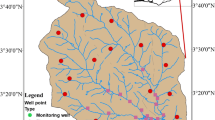Abstract
Surface water bodies interact with underlying aquifer systems, creating a complex flow system and flow paths. In general, a surface water body may be classified as gaining, losing, or flow through on the basis of its interaction with the surrounding aquifer. In the Nile Valley, the quaternary aquifer system is in a direct hydraulic interaction with the River Nile, canals, and drains. In this study, a regional numerical model was developed and used to evaluate the interaction between surface water bodies and the quaternary aquifer system in the Nile Valley. The solution is considered for a quasi three-dimensional, steady-state groundwater flow. The model used simulates the interaction between surface water bodies and groundwater for saturated and unsaturated flow conditions. In addition, a hydrodynamic model was used to simulate different extreme (high and low) scenarios for Nile surface water levels along the distance between Old Aswan Dam and Delta Barrages. Model calibration shows close results, and the model was used to simulate surface water levels. Results indicate that the Nile River acts as a drain for the quaternary aquifer (gaining water from the aquifer), although in the reaches upstream of the main barrages, the Nile loses the water, recharging the aquifer. All other main canals are recharging the aquifer system. The seepage rate depends mainly on the difference in piezometric head between the aquifer system and surface water bodies, as well as the hydraulic conductance of the base layer sediments of the surface water body. The model was used to evaluate the regional water balance for the Nile Valley and to estimate the surface water bodies' gains and losses.







Similar content being viewed by others
References
Ackerer Ph, Esteves M, Kohane R (1990) Modelling interactions between groundwater and surface water: a case study. In: Computational Methods in Subsurface Hydrology, Proc. 8th Intentional Conference Computational Methods in Water Resources. Springer, Berlin, pp 69–75
Anderson EI (2003) An analytical solution representing groundwater–surface water interaction. Water Resour Res 39(3):321–337
Anderson MP, Woessner WW (1992) Applied groundwater modeling. Academic Press, San Diego
Attia, F. A., 1985, Management of water systems in Upper Egypt. PhD thesis, Faculty of Engineering, Cairo, University, Cairo, Egypt, pp 230
Born SM, Smith SA, Stephenson DA (1979) Hydrogeological of glacialterrain lakes with management and planning applications. J Hydrol 43:7–43
Brooks RH, Corey AT (1966) Properties of porous media affecting fluid flow. American Society of Civil Engineers. J Irrig Drain Div 92(IR2):61–88
Calver A (2001) Riverbed permeabilities: information from pooled data. Groundwater 39(4):546–553
Fox GA, Durnford DS (2003) Unsaturated hyporheic zone flow in stream/aquifer conjunctive systems. Adv Water Resour 26(9):989–1000
Kacimov AR (2000) Three-dimensional groundwater flow to a lake: an explicit analytical solution. J Hydrol 240:80–89
Nield SP, Towenley LR, Barr AD (1994) A framework for quantitative analysis of surface water-groundwater interaction: flow geometry in a vertical section. Water Resour Res 30(8):2461–2475
Panday S, Huyakorn PS (2004) A fully coupled physically-based specially distributed model for evaluating surface/subsurface flow. Adv Water Resour 27:361–382
RIGW, 1980. The groundwater in Upper Egypt. Technical Report, Cairo, Egypt
RIGW, 2000. Groundwater wells inventory for the Nile Valley and Delta. NWRP Technical Report No. 4, Cairo, Egypt
RIGW, 2001. Final Technical Report for the Nile Valley Regional Model. Prepared for NWRP Project, Ministry of Water Resources and Irrigation, Cairo, Egypt
RIGW/IWACO, 2000. The environmental management of groundwater resources in Egypt. Final Report, Cairo, Egypt
Rushton KR, Tomlinson LM (1979) Possible mechanisms for leakage between aquifers and rivers. J Hydrol 40:49–65
Senarath SU, Ogden FL, Downer CW, Sharif HO (2000) On the calibration and verification of two-dimensional horizontal, distributed and continuous watershed models. Water Resour Res 36(6):1495–1510
Smith RE, Goodrich DC, Quinton JN (1995) Dynamic distributed simulation of watershed erosion, The KINEROs2 and EUROSEM models. J Soil Water Conserv 50(5):517–520
Sophocleus M (2002) Interactions between groundwater and surface water: the state of the science. Hydrogeological J 10:52–67
Townley LR, Trefry MG (2000) Surface water–groundwater interaction near shallow circular lakes: flow geometry in three dimensions. Water Resour Res 36(4):935–948
TRIWACO (1992) Groundwater modeling system: manual for version 6.0. IWACO, Rotterdam
van Genuchten MT (1980) A closed-form equation for predicting the hydraulic conductivity of unsaturated soils. J Am Soc Soil Sci 44:892–898
van Genuchten M. T., G. F. Pinder and W. P. Saukin. 1977. Modeling of leachate and soil interactions in an aquifer, Management of Gas and Leachate in Landfills. US Environmental Protection Agency, Rep. EPA-600/9-77-026, p. 95–103.
Warner JW, Gates TG, Attia FA, Mankarious WF (1991) Vertical leakage in Egypt’s Nile Valley: estimation and implications. J Irrig Drainage Eng, ASCE 117(4):515–533
Winter TC (1976) Numerical simulation analysis of the interaction of lakes and groundwater. USGS, Prof Pap 1001:1–45
Author information
Authors and Affiliations
Corresponding author
Rights and permissions
About this article
Cite this article
Dawoud, M.A., Ismail, S.S. Saturated and unsaturated River Nile/groundwater aquifer interaction systems in the Nile Valley, Egypt. Arab J Geosci 6, 2119–2130 (2013). https://doi.org/10.1007/s12517-011-0483-4
Received:
Accepted:
Published:
Issue Date:
DOI: https://doi.org/10.1007/s12517-011-0483-4




